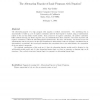Free Online Productivity Tools
i2Speak
i2Symbol
i2OCR
iTex2Img
iWeb2Print
iWeb2Shot
i2Type
iPdf2Split
iPdf2Merge
i2Bopomofo
i2Arabic
i2Style
i2Image
i2PDF
iLatex2Rtf
Sci2ools
PODS
1989
ACM
1989
ACM
The Alternating Fixpoint of Logic Programs with Negation
The alternating xpoint of a logic program with negation is de ned constructively. The underlying idea is monotonically to build up a set of negative conclusions until the least xpoint is reached, using a transformation related to the one that de nes stable models. From a xed set of negative conclusions, the positive conclusions follow
without deriving any further negative ones
, by traditional Horn clause semantics. The union of positive and negative conclusions is called the alternating xpoint partial model. The name alternating" was chosen because the transformation runs in two passes; the rst pass transforms an underestimate of the set of negative conclusions into an
intermediate
overestimate; the second pass transforms the overestimate into a new underestimate; the composition of the two passes is monotonic. The principal contributions of this work are
1
that the alternating xpoint partial model is identical to the well-founded partial model, and
2
that alternating xpo...
| Added | 11 Aug 2010 |
| Updated | 11 Aug 2010 |
| Type | Conference |
| Year | 1989 |
| Where | PODS |
| Authors | Allen Van Gelder |
Comments (0)

